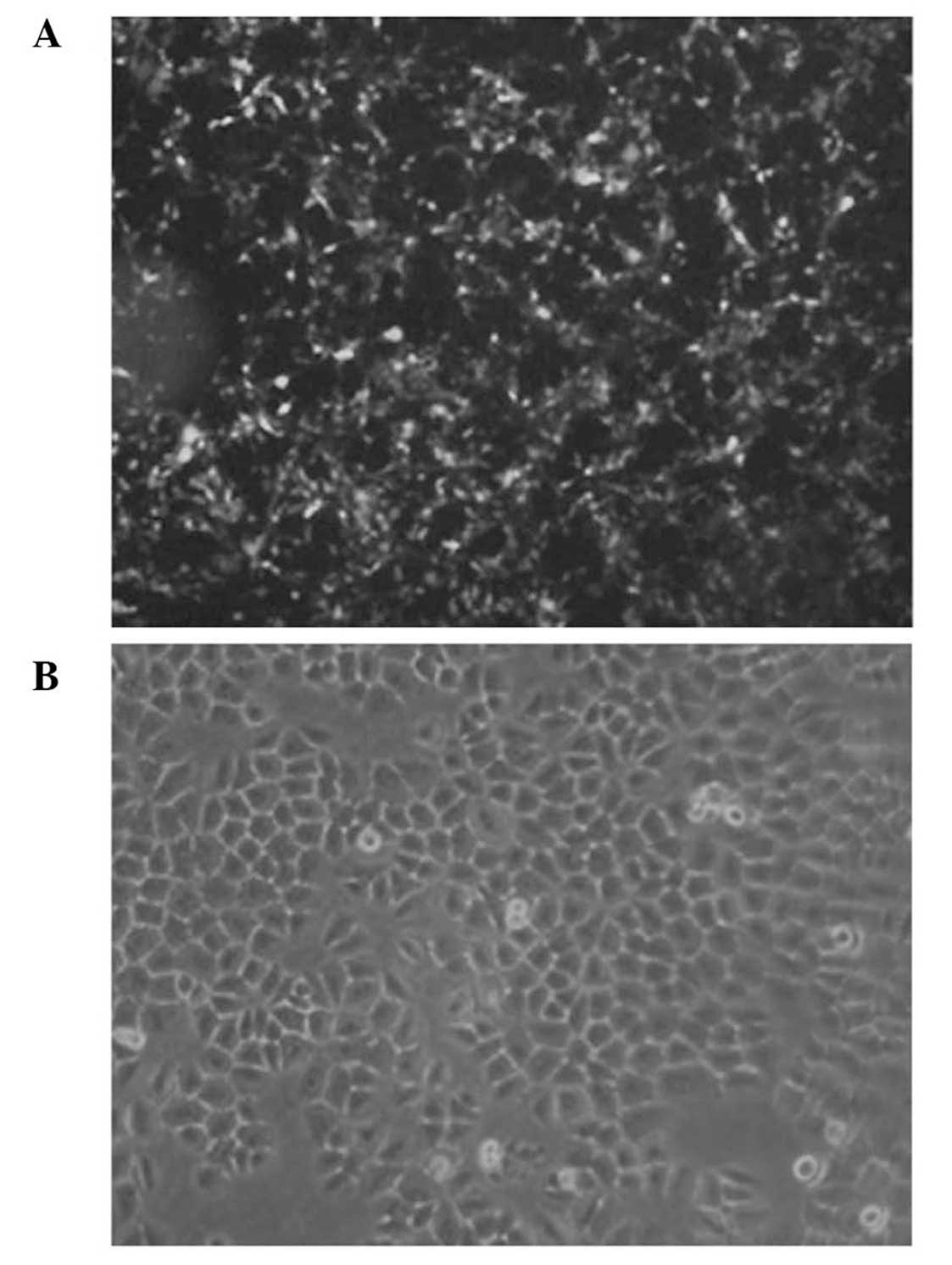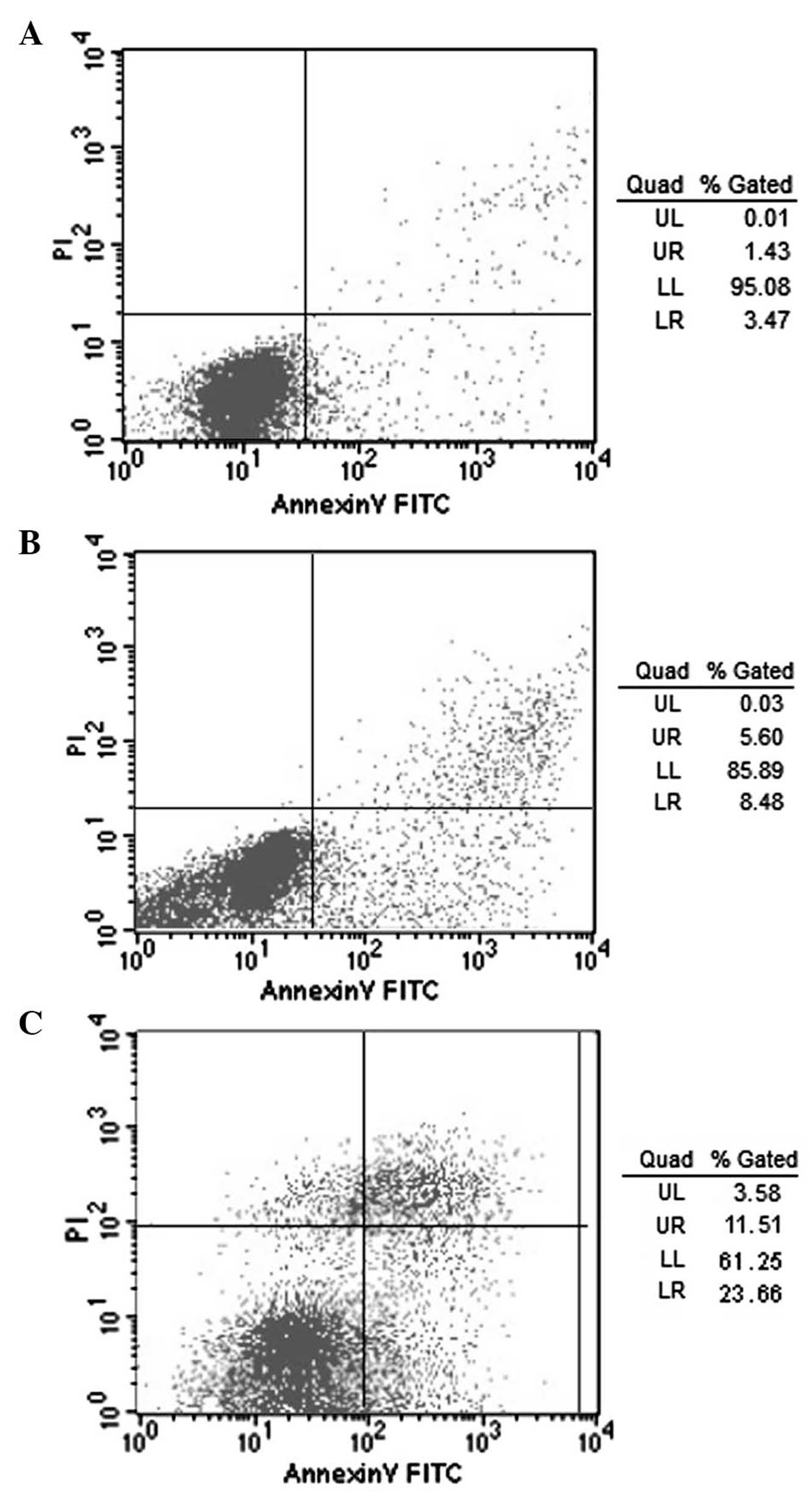|
1
|
Lordick F and Siewert JR: Recent advances
in multimodal treatment for gastric cancer: a review. Gastric
Cancer. 8:78–85. 2005. View Article : Google Scholar : PubMed/NCBI
|
|
2
|
Bang YJ, Van Cutsem E, Feyereislova A, et
al: Trastuzumab in combination with chemotherapy versus
chemotherapy alone for treatment of HER2-positive advanced gastric
or gastro-oesophageal junction cancer (ToGA): a phase 3,
open-label, randomised controlled trial. Lancet. 376:687–697. 2010.
View Article : Google Scholar : PubMed/NCBI
|
|
3
|
Zhang J, Liu H, Zhu R, Hinterdorfer P,
Zhang B and Tang J: Single molecular dissection of the ligand
binding property of epidermal growth factor receptor. Analyst.
138:5325–5331. 2013. View Article : Google Scholar : PubMed/NCBI
|
|
4
|
Liakakos T, Xeropotamos N, Ziogas D and
Roukos D: EGFR as a prognostic marker for gastric cancer. World J
Surg. 32:1225–1226. 2008. View Article : Google Scholar : PubMed/NCBI
|
|
5
|
Janjigian YY, Tang LH, Coit DG, et al: MET
expression and amplification in patients with localized gastric
cancer. Cancer Epidemiol Biomarkers Prev. 20:1021–1027. 2011.
View Article : Google Scholar : PubMed/NCBI
|
|
6
|
Huang TJ, Wang JY, Lin SR, Lian ST and
Hsieh JS: Overexpression of the c-met protooncogene in human
gastric carcinoma - correlation to clinical features. Acta Oncol.
40:638–643. 2001. View Article : Google Scholar
|
|
7
|
Drebber U, Baldus SE, Nolden B, et al: The
overexpression of c-met as a prognostic indicator for gastric
carcinoma compared to p53 and p21 nuclear accumulation. Oncol Rep.
19:1477–1483. 2008.PubMed/NCBI
|
|
8
|
Amemiya H, Menolascino F and Peña A: Role
of the expression of c-Met receptor in the progression of gastric
cancer. Invest Clin. 51:369–380. 2010.(In Spanish).
|
|
9
|
Namiki Y, Namiki T, Yoshida H, et al:
Preclinical study of a ‘tailor-made’ combination of NK4-expressing
gene therapy and gefitinib (ZD1839, Iressa) for disseminated
peritoneal scirrhous gastric cancer. Int J Cancer. 118:1545–1555.
2006. View Article : Google Scholar
|
|
10
|
Rojo F, Tabernero J, Albanell J, et al:
Pharmacodynamic studies of gefitinib in tumor biopsy specimens from
patients with advanced gastric carcinoma. J Clin Oncol.
24:4309–4316. 2006. View Article : Google Scholar : PubMed/NCBI
|
|
11
|
Dragovich T, McCoy S, Fenoglio-Preiser CM,
et al: Phase II trial of erlotinib in gastroesophageal junction and
gastric adenocarcinomas: SWOG 0127. J Clin Oncol. 24:4922–4927.
2006. View Article : Google Scholar : PubMed/NCBI
|
|
12
|
Zheng Y, Asara JM and Tyner AL:
Protein-tyrosine kinase 6 promotes peripheral adhesion complex
formation and cell migration by phosphorylating p130 CRK-associated
substrate. J Biol Chem. 287:148–158. 2012. View Article : Google Scholar :
|
|
13
|
Chell V, Balmanno K, Little AS, et al:
Tumour cell responses to new fibroblast growth factor receptor
tyrosine kinase inhibitors and identification of a gatekeeper
mutation in FGFR3 as a mechanism of acquired resistance. Oncogene.
32:3059–3070. 2013. View Article : Google Scholar
|
|
14
|
Tian W, Chen J, He H and Deng Y: MicroRNAs
and drug resistance of breast cancer: basic evidence and clinical
applications. Clin Transl Oncol. 15:335–342. 2013. View Article : Google Scholar
|
|
15
|
Karamouzis MV, Konstantinopoulos PA and
Papavassiliou AG: Targeting MET as a strategy to overcome
crosstalk-related resistance to EGFR inhibitors. Lancet Oncol.
10:709–717. 2009. View Article : Google Scholar : PubMed/NCBI
|
|
16
|
Onitsuka T, Uramoto H, Nose N, et al:
Acquired resistance to gefitinib: the contribution of mechanisms
other than the T790M, MET, and HGF status. Lung Cancer. 68:198–203.
2010. View Article : Google Scholar
|
|
17
|
Bean J, Brennan C, Shih JY, et al: MET
amplification occurs with or without T790M mutations in EGFR mutant
lung tumors with acquired resistance to gefitinib or erlotinib.
Proc Natl Acad Sci USA. 104:20932–20937. 2007. View Article : Google Scholar : PubMed/NCBI
|
|
18
|
Cao WG, Ma T, Li JF, et al: Effect of
gefitinib on radiosensitivity of gastric cancer cell lines. Chinese
Journal of Cancer. 26:1330–1335. 2007.(In Chinese).
|
|
19
|
Fushida S, Yonemura Y, Urano T, et al:
Expression of hepatocyte growth factor(hgf) and C-met gene in human
gastric-cancer cell-lines. Int J Oncol. 3:1067–1070.
1993.PubMed/NCBI
|
|
20
|
Casagrande G, te Kronnie G and Basso G:
The effects of siRNA-mediated inhibition of E2A-PBX1 on EB-1 and
Wnt16b expression in the 697 pre-B leukemia cell line.
Haematologica. 91:765–771. 2006.PubMed/NCBI
|
|
21
|
Li Y, Huang X, Zhong W, Zhang J and Ma K:
Ganglioside GM3 promotes HGF-stimulated motility of murine hepatoma
cell through enhanced phosphorylation of cMet at specific tyrosine
sites and PI3K/Akt-mediated migration signaling. Mol Cell Biochem.
382:83–92. 2013. View Article : Google Scholar : PubMed/NCBI
|
|
22
|
Kao J, Sikora AT and Fu S: Dual EGFR and
COX-2 inhibition as a novel approach to targeting head and neck
squamous cell carcinoma. Curr Cancer Drug Targets. 9:931–937. 2009.
View Article : Google Scholar : PubMed/NCBI
|
|
23
|
Chen HJ, Mok TS, Chen ZH, et al:
Clinicopathologic and molecular features of epidermal growth factor
receptor T790M mutation and c-MET amplification in tyrosine kinase
inhibitor-resistant Chinese non-small cell lung cancer. Pathol
Oncol Res. 15:651–658. 2009. View Article : Google Scholar : PubMed/NCBI
|
|
24
|
Rosenzweig SA: Acquired resistance to
drugs targeting receptor tyrosine kinases. Biochem Pharmacol.
83:1041–1048. 2012. View Article : Google Scholar : PubMed/NCBI
|
|
25
|
Agarwal S, Zerillo C, Kolmakova J, et al:
Association of constitutively activated hepatocyte growth factor
receptor (Met) with resistance to a dual EGFR/Her2 inhibitor in
non-small-cell lung cancer cells. Br J Cancer. 100:941–949. 2009.
View Article : Google Scholar : PubMed/NCBI
|
|
26
|
Kosaka T, Yamaki E, Mogi A and Kuwano H:
Mechanisms of resistance to EGFR TKIs and development of a new
generation of drugs in non-small-cell lung cancer. J Biomed
Biotechnol. 2011:1652142011. View Article : Google Scholar : PubMed/NCBI
|
|
27
|
Engelman JA, Zejnullahu K, Mitsudomi T, et
al: MET amplification leads to gefitinib resistance in lung cancer
by activating ERBB3 signaling. Science. 316:1039–1043. 2007.
View Article : Google Scholar : PubMed/NCBI
|
|
28
|
Que W and Chen J: Knockdown of c-Met
inhibits cell proliferation and invasion and increases
chemosensitivity to doxorubicin in human multiple myeloma U266
cells in vitro. Mol Med Rep. 4:343–349. 2011.PubMed/NCBI
|
|
29
|
Wang ZX, Lu BB, Yang JS, Wang KM and De W:
Adenovirus-mediated siRNA targeting c-Met inhibits proliferation
and invasion of small-cell lung cancer (SCLC) cells. J Surg Res.
171:127–135. 2011. View Article : Google Scholar
|
|
30
|
Xie B, Xing R, Chen P, et al:
Down-regulation of c-Met expression inhibits human HCC cells growth
and invasion by RNA interference. J Surg Res. 162:231–238. 2010.
View Article : Google Scholar
|
|
31
|
Shinomiya N, Gao CF, Xie Q, et al: RNA
interference reveals that ligand-independent met activity is
required for tumor cell signaling and survival. Cancer Res.
64:7962–7970. 2004. View Article : Google Scholar : PubMed/NCBI
|
|
32
|
Teng L and Lu J: cMET as a potential
therapeutic target in gastric cancer (Review). Int J Mol Med.
32:1247–1254. 2013.PubMed/NCBI
|
|
33
|
Wheeler DL, Huang S, Kruser TJ, et al:
Mechanisms of acquired resistance to cetuximab: role of HER (ErbB)
family members. Oncogene. 27:3944–3956. 2008. View Article : Google Scholar : PubMed/NCBI
|
|
34
|
Sequist LV, von Pawel J, Garmey EG, et al:
Randomized phase II study of erlotinib plus tivantinib versus
erlotinib plus placebo in previously treated non-small-cell lung
cancer. J Clin Oncol. 29:3307–3315. 2011. View Article : Google Scholar : PubMed/NCBI
|














